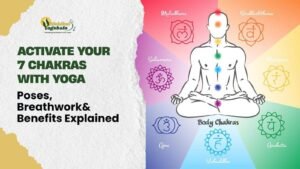Prasarita Padottanasana – Top 7 health benefits
- Blog
- /
- Health Benefits of Yoga
- /
- Prasarita Padottanasana – Top...

Prasarita Padottanasana: A Comprehensive Guide
Prasarita Padottanasana, also known as the Wide-Legged Forward Bend Pose, is a significant posture in the Ashtanga Yoga Primary Series. This pose comes in four variations—A, B, C, and D—and is renowned for stretching and strengthening the body. Its semi-inverted nature revitalises it, helping practitioners achieve greater ease in their practice and daily life. The name “Prasarita Padottanasana” translates from Sanskrit to English as follows: ‘Prasarita’ means wide or stretched out, ‘Pada’ means foot, ‘Ut’ means intense, ‘Tan’ means stretch, and ‘Asana’ means pose.
This pose is central to the standing-forward poses and targets the entire body. Practitioners who frequently perform intense backbends often use Prasarita Padottanasana to counterbalance and bring harmony to their practice. Here’s a list of benefits that make this asana an essential addition to any yoga sequence:

Benefits of Prasarita Padottanasana
Lets us discuss some common Prasarita Padottanasana Benefits:
1. Stretching the Lower Body
- The pose involves placing the feet wide apart, stretching the hamstrings and requiring the body to balance more intensely. This action strengthens the lower body and opens the hip flexors, which can become stiff from prolonged sitting.
- Areas benefited: Thighs, groin, hips, back, and hamstrings.
2. Refreshing the Mind
- The semi-inverted nature of the pose helps the heart rest by reducing the workload of pumping blood against gravity. This allows the brain to receive more oxygen and blood, activating brain cells, reducing stress, and alleviating brain fog.
3. Relieving Lower Backache
- Prasarita Padottanasana(Wide-Legged Forward Bend Pose) is recommended for those with lower back pain, sciatica, or a slipped disc. The pose stretches and elongates the hamstrings, hip flexors, and spine, increasing blood flow to the back and reducing muscle blockages.
4. Enhancing Digestion
- The forward bend massages the digestive organs, including the liver, spleen, kidneys, and intestines. This gentle massage aids in alleviating constipation, improving nutrient absorption, and detoxifying the body.
5. Improving Posture
- Regular practice of this pose stretches and strengthens the spinal column, leading to a better posture with an elongated spine, squared shoulders, and a toned abdomen. This helps in creating long, lean lines and enhances overall posture.
6. Activating the Energy Centre
- The pose helps activate the Crown Chakra when the head is placed on the mat, promoting a state of balance and tranquillity. It grounds negative thoughts and uplifts mood while keeping the legs steady and rooted.
7. Other Prasarita Padottanasana Benefits
- This asana can also help reduce headaches, improve insomnia, and control blood sugar levels.
Also Read – 8 Intense Ashtanga Yoga Poses to Heat You Up
Conclusion
Incorporating Prasarita Padottanasana into your practice—whether as a part of a full yoga session or as a standalone pose in the morning—can address a variety of common ailments and enhance overall well-being. Consider exploring 100 Hour Yoga Teacher Training, 200 hour Yoga Teacher Training in India at Rishikul Yogshala for more information on integrating this pose into your routine.

MEDITATION, INSPIRATIONAL AND SPIRITUAL GUIDE
Yogi Gangesha Chaitanya is a master of Yoga Philosophy, Meditation, Pranayama, and Spiritual Guidance, trained under Swami Rama and renowned institutions like the Himalayan Tradition and Sri Aurobindo Ashram. With expertise in Kundalini Yoga and meditation, he mentors students in 200-hour and 300-hour Yoga Teacher Training programs, guiding them toward inner awareness, spiritual growth, and a deeper understanding of yoga.
View Instagram Profile









